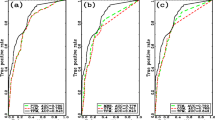Abstract
The ability to predict corporate financial distress can be strengthened using models that account for serial correlation in the data, incorporate information from more than one period and include stationary explanatory variables. This paper develops a stationary financial distress model for AMEX and NYSE manufacturing and retailing firms based on the statistical methodology of time-series Cumulative Sums (CUSUM). The model has the ability to distinguish between changes in the financial variables of a firm that are the result of serial correlation and changes that are the result of permanent shifts in the mean structure of the variables due to financial distress. Tests performed show that the model is robust over time and outperforms similar models based on the popular statistical methods of Linear Discriminant Analysis and Logit.
Similar content being viewed by others
References
Altman, E.I., “Financial Ratios, Discriminant Analysis and the Prediction of Corporate Bankruptcy.” Journal of Finance 23, 589-609, (1968).
Altman, E.I., R.G. Haldeman, and P. Narayanan, “Zeta Analysis, a New Model for Identifying Bankruptcy Risk of Corporation.” Journal of Banking and Finance 1, 29-54, (1977).
Amemiya, T., “Qualitative Response Models: A Survey.” Journal of Economic Literature 19, 1483-1536, (1981).
Beaver, W.H., “Financial Ratios as Predictors of Failure.” Journal of Accounting Research Supplement, 71-111, (1966).
Chu, C.J. and H. White, “A Direct Test for Changing Trend.” Journal of Business and Economics Statistics 10, 289-299, (1992).
Dickey, D.A. and W.A. Fuller, “Distribution of the Estimators for Autoregressive Time Series with a Unit Root.” Journal of the American Statistical Association 74, 427-431, (1979).
Edmister, R.O., “An Empirical Test of Financial Ratio Analysis for Small Business Failure Prediction.” Journal of Financial and Quantitative Analysis 7, 1477-1493, (1972).
Efron, B., The Jackknife, the Bootstrap and Other Resampling Plans, SIAM, Philadelphia, Pennsylvania, 1982.
Gombola, M.J., M.E. Haskins, J.E. Ketz, and D. Williams, “Cash Flow in Bankruptcy Prediction.” Financial Management 16, 55-65, (1987).
Johansen, S., Likelihood-Based Inference in Cointegrated Vector Auto-Regressive Models, Advanced Texts in Econometrics, Oxford University Press:, New York, 1995.
Judge, G.G., W.E. Griffiths, R.C. Hill, Helmut Lutkepohl, and Tsoung-Chao Lee, The Theory and Practice of Econometrics, John Wiley: New York, 1985.
Lee, C.F. and C. Wu, “Expectation Formation and Financial Ratio Adjustment Processes.” The Accounting Review 63, 292-306, (1988).
Lo, A.W., “Logit Versus Discriminant Analysis: A Specification Test and Application to Corporate Bankruptcies.” Journal of Econometrics 31, 151-178, (1986).
Lorden, G., “Procedures for Reacting to a Change in Distribution.” Annals of Mathematical Statistics 42, 1897-1908, (1971).
Marks, S. and O.J. Dunn, “Discriminant Functions when Covariance Matrices are Unequal.” Journal of the American Statistical Association 69, 555-559, (1974).
McLachlan, G.J., “Estimation of Error Rates.” Discriminant Analysis and Statistical Pattern Recognition Wiley, New York, Ch. 10, 337-377, (1992).
Neftci, S.N., “Optimal Prediction of Cyclical Downturns.” Journal of Economic Dynamics and Control 6, 225-241, (1982).
Neftci, S.N., “A Note on the Use of Local Maxima to Predict Turning Points in Related. Series.” Journal of the American Statistical Association 80, 553-557, (1985).
Ohlson, J.A., “Financial Ratios and the Probabilistic Prediction of Bankruptcy.” Journal of Accounting Research 18, 109-131, (1980).
Siegmund, D., Sequential Analysis: Tests and Confidence Intervals, Springer Series in Statistics, Springer-Verlag, New York, 1985.
Pastena, V. and W. Ruland, “The Merger/Bankruptcy Alternative.” The Accounting Review 61, 288-301, (1986).
Pollak, M. and D. Siegmund, “Approximations to the Sample Size of Certain Sequential Tests.” The Annals of Statistics 3, 1267-1282, (1975).
Theodossiou, P., “Predicting Shifts in the Mean of a Multivariate Time Series Process: An Application in Predicting Business Failures.” Journal of the American Statistical Association 88, 441-449, (1993).
Theodossiou, P., and E. Kahya, “Non-Stationarities in Financial Variables and the Prediction of Business Failures.” 1996 Proceedings of the Business and Economic Statistics Section. American Statistical Association 130-133, (1996).
Theodossiou, P., E. Kahya, G.C. Philippatos, and R. Saidi, “Financial Distress Corporate Acquisitions: Further Empirical Evidence.” Journal of Business Finance and Accounting 23, (1996).
Wecker, W.E., “Prediction of Turning Points.” Journal of Business 52, 35-50, (1979).
Author information
Authors and Affiliations
Rights and permissions
About this article
Cite this article
Kahya, E., Theodossiou, P. Predicting Corporate Financial Distress: A Time-Series CUSUM Methodology. Review of Quantitative Finance and Accounting 13, 323–345 (1999). https://doi.org/10.1023/A:1008326706404
Issue Date:
DOI: https://doi.org/10.1023/A:1008326706404




